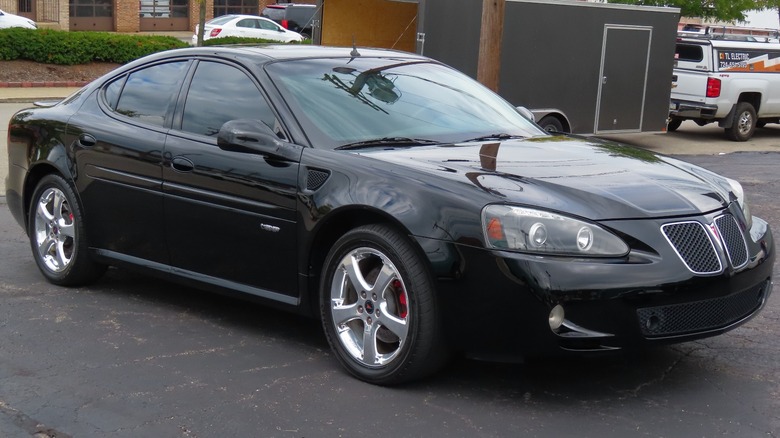Which Pontiac Grand Prix Came With An LS V8, And How Much Horsepower Did It Have?
The Pontiac Grand Prix was one of the automaker's muscle-car-with-a-suburban-veneer vehicles with more under the hood than casual observers might guess. Manufactured since 1962, the Grand Prix evolved from a coupe to a four-door sedan and entered its seventh generation in 2004.
This generation offered a 3.8L V6 engine with 200 hp for its GT trim. Like an increasing number of cars in its class at that time, it used front-wheel drive. The GTP trim bumped the car up to 260 hp, thanks to its supercharged engine.
In a bid for that old excitement, Pontiac decided in 2005 to bring back a V8 to the popular model, introducing the GXP trim with this Grand Prix generation. There hadn't been a V8 standard in a Grand Prix since the third generation in the 1970s. However, unlike the very first V8 Grand Prix, this model's 5.3L V8 sat over the drive wheels up front and offered a huge boost in horsepower over the other trims.
[Featured image by MercurySable99 via Wikimedia Commons | Cropped and scaled | CC BY- SA 4.0]
One engine to rule them all -- almost
The GXP packed a 5.3 LS engine onto the Pontiac's W platform, which was created to house a transverse V6. Because of that, the engine required some mods to fit, including changes to the crankshaft and drive belts to allow the GXP to harness a mighty 303 horses.
The LS engine was a mainstay for General Motors starting in 1997, with variations powering performance cars like the Chevrolet Corvette and Camaro and Pontiac FIrebird Trans Am. It also became a favorite of tuners and supercar makers who wanted a tunable engine with high horsepower potential.
In fact, tuner and automaker Hennessey selected an LS V8 engine for its supercar Venom GT. The Venom produced 1,200 horsepower from its twin-turbocharged engine. That horsepower combined with a lightweight chassis based on the Lotus Elise meant it could almost fly.
But in the front-wheel-drive GXP sedan, this big engine's forward placement gave engineers the extra challenges of understeer and torque steering issues -– when a car pulls right or left under acceleration — that came with this design. Pontiac addressed the problem in part by selling the GXP with wider tires at the front than the rear to lessen oversteer. The carmaker also worked with Bridgestone to design tires to help dampen the torque steering, with Bridgestone Potenza RE050As 255/45-18 up front and 225/50-18 in the rear.
[Featured image by Supermac1961 via Wikimedia Commons | Cropped and scaled | CC BY- 2.0]
So much for the front-wheel-drive V8
By 2008, the Pontiac Grand Prix was down to two flavors -– the base model with a non-supercharged V6 and the GXP. The GXP was still revered for its V8, magnificent trunk size, and horsepower-per-dollar cost. But reviewers like Edmunds said its interior plastics looked outdated and cheap, and that it wasn't very fuel-efficient. And its V8-over-front-drive-wheels handling suffered in comparison to other cars in its class.
Despite Car and Driver testing the GXP and reporting that it went from 0-60 mph in 5.7 seconds and produced 303 hp, the variant lost favor against smaller, nimbler imports like the Toyota Camry. Even Pontiac's sister V8, the G8, was proving to be stiff competition, ticking off boxes that the Grand Prix should have, but in a more conventional rear-wheel drive model. By 2008, the G8 GT boasted more horsepower than the Grand Prix: 361 hp from its 6.0-liter V8.
Pontiac pulled the plug on the GXP (and the Grand Prix) that year, and in 2010, GM pulled the plug on Pontiac.
[Featured image by Bull-Doser via Wikimedia Commons | Cropped and scaled | Public domain]


